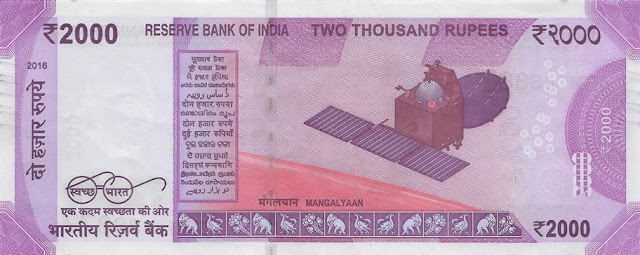Item code: 107/IN-30
(1) Swachh Bharat logo with slogan.
Year
|
2016
|
Obverse
|
Portrait of Mahatma Gandhi; Lion Capital of Ashoka near water mark; RBI seal
|
Reverse
|
Mangalyaan (Mars mission)
|
Watermark
|
Mahatma Gandhi, 2000
|
Size
|
166 x 66 mm
|
Signature
|
Urjit R. Patel
|
About the Currency:
The Indian 2000-rupee banknote (₹2000) is a denomination of the Indian rupee. It was released by the Reserve Bank of India (RBI) on 8 November 2016 after the demonetisation of ₹500 and ₹1000 banknotes and is in circulation since 10 November 2016. It is a part of the Mahatma Gandhi New Series of banknotes with a completely new design. The Indian ₹2000 rupee note is the highest currency note printed by RBI that is in active circulation, ever since the 10,000 rupee note was demonetised in January 1978. Before the official announcement by RBI, media reported that ₹2000 notes have been printed from the currency printing press in Mysore by the end of October 2016.
1. See through register where the numeral 2,000 can be seen when note is held against light.
2. Latent image of 2,000 can be seen when the note is tilted.
3. Denominational numeral २००० in Devanagari.
4. Portrait of Mahatma Gandhi at the centre.
5. Micro letters 'RBI' and '2000' on the left side of the banknote.
6. Colour shift security thread with 'RBI' and '2,000'
7. Guarantee clause, Governor's signature and RBI emblem on the right.
8. Watermarks of Mahatma Gandhi and electrotype 2,000 numeral.
9. Number panel with numerals growing from small to big on top left and bottom right sides.
10. Denominational numeral with Rupee symbol, 2,000 in colour changing ink
11. Ashoka pillar emblem.
For visually impaired:
12. Rectangle with Rs.2,000 in raised print on right.
13. Seven angular bleed lines in raised print.
Design
The ₹2000 banknote of the Mahatma Gandhi New Series is 66 × 166 mm magenta coloured, with the obverse side featuring a portrait of Mahatma Gandhi as well as the Ashoka Pillar Emblem, with a signature of Reserve Bank of India Governor. It has the Braille feature to assist the visually challenged in identifying the currency. The reverse side features a motif of the Mangalyaan, depicting the India's first interplanetary space mission and the logo and a tag line of Swachh Bharat Abhiyan.
|
Reverse description :
Back side features
(2) Motif of Mangalayan.
(3) Denominational numeral २००० in Devanagari.
Swachh Bharat Abhiyan
Swachh Bharat Abhiyan is a campaign by the Government of India, covering 4,041 statutory cities and towns, to clean the streets, roads and infrastructure of the country. The campaign was officially launched on 2 October 2014 at Rajghat, New Delhi, by Prime Minister Narendra Modi. It is India's biggest ever cleanliness drive with 3 million government employees and school and college students of all Indian participating in the campaign.
Mangalayan
The Mars Orbiter Mission (MOM), also called Mangalyaan is a space probe orbiting Mars since 24 September 2014. It was launched on 5 November 2013 by the Indian Space Research Organisation (ISRO). It is India's first interplanetary mission and ISRO has become the fourth space agency to reach Mars, after the Soviet space program, NASA, and the European Space Agency. It is the first Asian nation to reach Mars orbit, and the first nation in the world to do so in its first attempt.
Devanagari
The Nagari script has roots in the ancient Brāhmī script family. Some of the earliest epigraphical evidence attesting to the developing Sanskrit Nagari script in ancient India, in a form similar to Devanagari, is from the 1st to 4th century CE inscriptions discovered in Gujarat. The Devanagari script is used for over 120 languages, including Hindi, Marathi, Nepali, Pali, Konkani, Bodo, Sindhi and Maithili among other languages and dialects, making it one of the most used and adopted writing systems in the world.







No comments:
Post a Comment